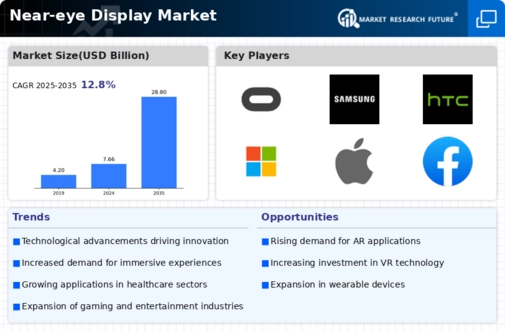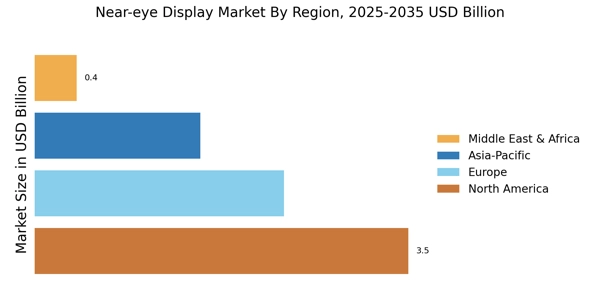Technological Advancements
The Near-eye Display Market is experiencing rapid technological advancements that enhance user experience and functionality. Innovations in optics, display resolution, and miniaturization of components are driving the development of more sophisticated near-eye displays. For instance, the integration of augmented reality (AR) and virtual reality (VR) technologies is becoming increasingly prevalent, allowing for immersive experiences in various applications such as gaming, education, and training. According to recent data, the market for AR and VR devices is projected to reach substantial figures, indicating a growing demand for near-eye displays. These advancements not only improve visual quality but also expand the potential applications of near-eye displays, making them more appealing to consumers and businesses alike.
Increased Adoption in Healthcare
The Near-eye Display Market is witnessing increased adoption in the healthcare sector, where these devices are utilized for training, surgical assistance, and patient care. Near-eye displays facilitate enhanced visualization of complex medical data, allowing healthcare professionals to make informed decisions during procedures. The market data suggests that the use of AR in surgical settings is expected to grow significantly, as it provides real-time information overlay, improving accuracy and efficiency. This trend indicates a shift towards more technologically integrated healthcare solutions, where near-eye displays play a crucial role in enhancing patient outcomes and operational efficiency. As healthcare providers continue to seek innovative tools, the demand for near-eye displays is likely to rise.
Rising Interest in Smart Wearables
The Near-eye Display Market is witnessing a rising interest in smart wearables, which incorporate near-eye display technology for enhanced functionality. These devices, including smart glasses and head-mounted displays, are gaining traction among consumers seeking convenience and connectivity. Market data suggests that the wearables segment is expected to grow significantly, driven by advancements in technology and increasing consumer awareness. As more individuals embrace smart wearables for daily activities, the integration of near-eye displays is likely to become a standard feature, enhancing user experience and interaction. This trend indicates a shift towards more integrated and multifunctional devices, positioning near-eye displays as a key component in the evolution of wearable technology.
Expansion in Gaming and Entertainment
The Near-eye Display Market is experiencing significant expansion in the gaming and entertainment sectors, where immersive experiences are highly sought after. The integration of near-eye displays in gaming consoles and VR headsets is transforming how users engage with digital content. Market data reveals that the gaming industry is projected to grow substantially, with near-eye displays playing a pivotal role in delivering high-quality visuals and interactive experiences. This expansion is not limited to traditional gaming; it also encompasses live events and virtual reality experiences, indicating a broader acceptance of near-eye displays in various entertainment formats. As consumer preferences evolve, the demand for innovative gaming solutions is likely to drive further growth in this market.
Growing Demand for Remote Collaboration Tools
The Near-eye Display Market is benefiting from the growing demand for remote collaboration tools, particularly in professional settings. As organizations increasingly adopt hybrid work models, the need for effective communication and collaboration solutions has surged. Near-eye displays offer unique capabilities for virtual meetings, allowing participants to interact in a more immersive environment. Market data indicates that the demand for such technologies is on the rise, as businesses seek to enhance productivity and engagement among remote teams. This trend suggests that near-eye displays will become integral to the future of work, providing innovative solutions that facilitate seamless collaboration across distances.

















Leave a Comment